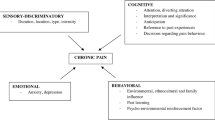Abstract
Pain occurs in more than 80% of cancer patients before death. During recent years major progress has taken place in our techniques for the adequate assessment of cancer pain. Major prognostic factors associated with the pain syndrome have been recognized. In addition, other prognostic factors associated with the characteristics of the patient have been defined. Valid tools have been developed that allow for the assessment of most of the prognostic variables associated with analgesic response. During recent years a major effort has been made to integrate the pain syndrome within the other complex symptoms that are often present in patients with advanced cancer. The interaction of pain and analgesic treatment with other symptoms and their management is discussed. Finally, areas where future research should focus in the area of the diagnosis and assessment of pain are discussed.
Similar content being viewed by others
References
Ahles TA, Blanchard EB, Ruckdeschel JC (1983) The multidimensional nature of cancer-related pain. Pain 17:277–288
American Joint Committee for Cancer Staging and End Result Reporting (1977) Manual for staging of cancer. Am Joint Committee, Chicago, Ill
Arner S, Meyerson BA (1988) Lack of analgesic effect of opioids on neuropathic and idiopathic forms of pain. Pain 33:11–33
Banning A, Stugren P, Henriksen H (1991) Treatment outcome in a multidisciplinary cancer pain clinic. Pain 47:129–134
Begent R, Bagshawe K (1982) Management of high risk choriocarcinoma. Semin Oncol 9:198–203
Bruera E, Chadwick S, Brenneis C, Michaud M, Bacovsky R, Emeno A, MacDonald RN (1988) Use of the subcutaneous route for the administration of narcotics in patients with cancer pain. Cancer 62:407–411
Bruera E, Brenneis C, Michaud M, MacDonald RN (1989) Influence of the Pain and Symptom Control Team (PSCT) on the patterns of treatment of pain and other symptoms in a cancer center. J Pain Symptom Manage 4:112–116
Bruera E, Macmillan K, Hanson J, MacDonald RN (1989) The Edmonton Staging System for Cancer Pain: preliminary report. Pain 37:203–209
Bruera P, Kuehn N, Miller MJ, Selmser P, Macmillan K (1991) The Edmonton Symptom Assessment System (ESAS): a simple method for the assessment of palliative care patients. J Palliat Care 7:6–9
Bruera E, Schoeller MT, Wenk R, Macmillan K, et al (1991) The Edmonton Staging System (ESS) for cancer pain: a prospective multicenter study (abstract 1144). Proc ASCO 10:27
Coyle N, Adelhardt J, Foley KM (1987) Changing patterns in pain, drug use and routes of administration in the advanced cancer patient. Presented at the 5th World Congress on Pain of the International Association for the Study of Pain, Marburg, Germany
Coyle N, Adelhardt J, Foley KM, et al (1990) Character of terminal illness in the advanced cancer patient: pain and other symptoms during the last four weeks of life. J Pain Symptom Manage 5:83–93
Dubner R (1991) A call for more science, not more rhetoric, regarding opioids and neuropathic pain (editorial). Pain 44:1
Fainsinger R, Bruera E, Miller MJ, Hanson J, MacEachern T (1991) Symptom control during the last week of life on a palliative care unit. J Palliat Care 7:5–11
Fishman B, Pasternak S, Wallenstein SL, et al (1987) The Memorial Pain Assessment Card. A valid instrument for the evaluation of cancer pain. Cancer 60:1151–1158
Foley K (1985) The treatment of cancer pain. N Engl J Med 313:84–95
Folstein MF, Folstein S, McHugh PR (1975) “Mini-mental state”: a practical method for grading the cognitive state of patients for the clinician. J Psychiatr Res 12:189–198
Grond S, Zech D, Schug SA, et al (1991) Validation of World Health Organization Guidelines for cancer pain relief during the last days and hours of life. J Pain Symptom Manage 6:411–422
IASP Subcommittee on Taxonomy (1986) Classification of chronic pain. Pain [Suppl] 3:S1-S225
Lamerton R (1980) Care of the dying. Penguin, New York
Macaluso C, Weinberg D, Foley KM (1988) Opioid abuse and misuse in a cancer pain population. J Pain Symptom Manage 3:S24
Marks R, Sachar E (1973) Undertreatment of medical in-patients with narcotic analgesics. Ann Intern Med 78:173–181
Mount B (1979) Medical applications of heroin. Can Med Assoc J 120:405–407
Minister of Supply and Services Canada (1984) Cancer pain. A monograph on the management of cancer pain. Health and Welfare Canada. Ottawa, H42-2/5
Paterson AHG (1988) Clinical staging and its prognostic significance. In: Stall B (ed) Pointers to cancer prognosis. Nijhoff, Dordrecht, pp 37–48
Portenoy RK, Coyle N (1990) Controversies in the long-term management of analgesic therapy in patients with advanced cancer. J Pain Symptom Manage 5:307–319
Portenoy RK, Hagen NA (1990) Breakthrough pain definition, prevalence and characteristics. Pain 41:273–281
Portenoy RK, Foley KM, Inturrisi CE (1990) The nature of opioid responsiveness and its implications for neuropathic pain: new hypotheses derived from studied of opioid infusion. Pain 43:273–286
Swerdlow M, Stjernsward J (1980) Cancer pain relief — an urgent problem. World Health. Forum 3:325–330
Twycross R (1984) Opioids. In: Wall P, Melzack R (eds) Textbook of pain. Churchill Livingstone, Edinburgh, pp 686–701
Valagussa P, Bonadonna G, Veronesi V (1978) Patterns of relapse and survival following radical mastectomy. Cancer 41:1170–1178
Ventafridda V, Caraceni A (1991) Cancer pain classification: a controversial issue. Pain 46:1–2
Ventafridda V, Ripamonti C, DeConnoF, et al (1990) Symptom prevalence and control during cancer patients' last days of life. J Palliat Care 6:7–11
WHO (1990) Cancer pain relief and palliative care. (WHO technical report series 804) World Health Organization, Geneva
Author information
Authors and Affiliations
Rights and permissions
About this article
Cite this article
Bruera, F., Watanabe, S. New developments in the assessment of pain in cancer patients. Support Care Cancer 2, 312–318 (1994). https://doi.org/10.1007/BF00365585
Issue Date:
DOI: https://doi.org/10.1007/BF00365585



